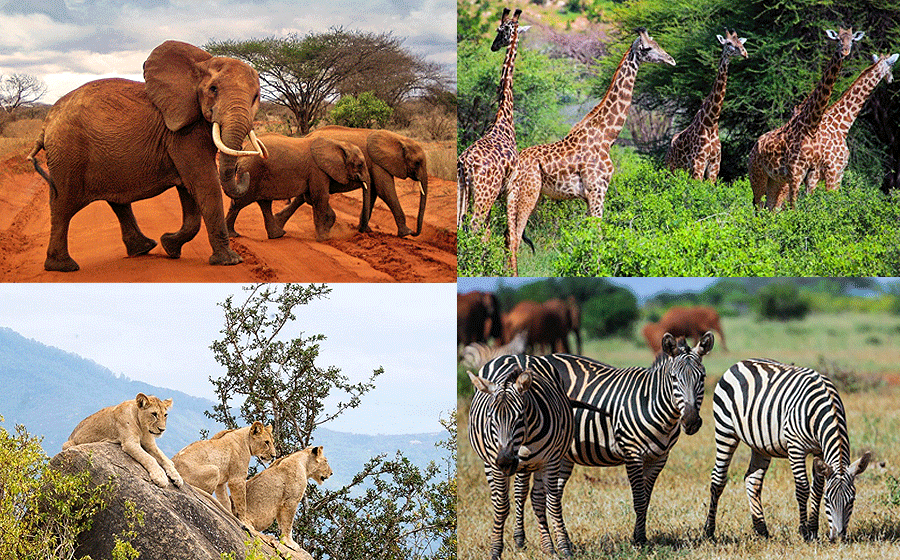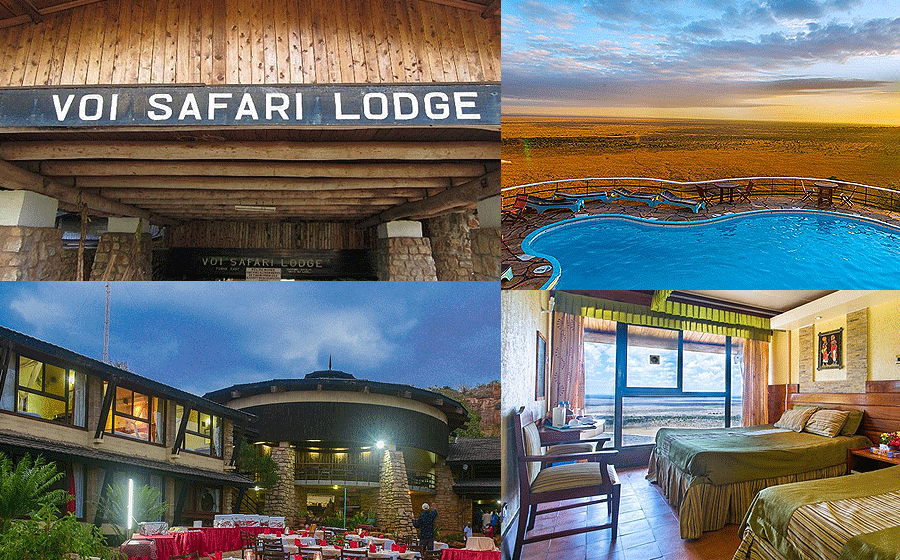Tsavo East National Park
Tsavo East National Park is one of the oldest parks in Kenya, located southeast of Kenya near the Town of Voi in the Taita-Taveta District of Coast Province, inland from the Coast, it is 13,747 sq. km in size. Tsavo National Park was established in 1948, covering about 22700km². The Tsavo Park was soon divided into two sections, along the major railway line bisecting the wilderness area, forming Tsavo East and Tsavo West National Parks. Today the Nairobi-Mombasa highway runs between the Tsavo national parks, both named after the Tsavo River that flows through the region. Tsavo East is within easy reach of Mombasa and the tropical beaches of East Africa.
Tsavo East National Park Getting There: The drive from Nairobi to Tsavo East National Park can be exciting especially if your guide knows the history of the various towns and shopping centres that you drive by. From Nairobi, the first significant town is Athi River, followed by Salama, Email, Kiboko, Kibwezi, Mtito Adei, Tsavo, Manyani, and finally Voi. Voi is only 160 km from Mombasa. Traveling from Nairobi will take at most 4 hours depending on the gate you use. Tsavo East National Park requires a smart card. The park headquarters are at Voi gate. Tsavo East National Park Gates: From Nairobi one can access Tsavo East Game Park through Mtito Adei Gate (240Km from Nairobi ), Tsavo gate (290Km), Manyani Gate (307 Km) or Voi Gate (340Km).
Wildlife: Tsavo East National Park is renowned for its large herds of elephants, often dramatically coated in fine red dust. The population is over 10,000 elephants strong. Tsavo East is also notorious for its lions – the ‘man-eating’ lions of Tsavo, in particular. The lions of Tsavo became famous when railway crews were attacked and many of the workers were eaten in 1898. Some reports estimate that the two lions killed about 135 people building a railway bridge over the Tsavo River, while recent evidence suggests that 34 people were eaten. Over the centuries of slave trading between East Africa and Arabia, countless slaves died en route to Mombasa – their bodies left behind in the Tsavo area, where lions most likely fed on the corpses.
The lions of Tsavo are today known for their short manes, compared to the males of other populations. The hot, dry habitat of Tsavo may be the reason for their shorter manes. In addition to its famous elephants and lions, Tsavo East is also home to the other members of the Big Five – leopard, buffalo, and rhino. The black rhino population is monitored to protect these endangered mammals from poachers, but they are rarely spotted on game drives. Tsavo East is also home to endangered hirola antelopes. Tsavo also hosts a wide variety of other wild animals, from cheetahs, hyenas, and crocodiles to hippos, giraffes, and Grevy’s zebra, along with species typical of northern Kenya, including gerenuk and Somali ostrich.
Over 500 bird species have been recorded in Tsavo East, including black kite, crowned crane, hornbill, lovebird, and sacred ibis. Tsavo East National Park consists largely of flat, dry plains and the Yatta Plateau, one of the world’s longest lava flows and a birding haven. The Galana River is another defining feature of the landscape, serving as one of the few permanent water sources in the national park. It is at the Galana River that the dusty red elephant herds gather and the tumbling rapids of Lugards Falls can be viewed. Because Tsavo East is flat and dry with sparser vegetation, it offers better chances of spotting wildlife at the few permanent water sources. Aruba Dam and the Glana River attract thousands of animals, making these ideal areas for game viewing.
Tsavo National Park activities include game drives, bird/nature walks, camping, visiting local villages, balloon safaris, and cultural dances. The main attractions in Tsavo East National Park include Mudanda Rock, Lugard Falls, Crocodile Point, Aruba Dam, Kanderi Swamp, Yatta Plateau, prehistoric lava flow, and Galana River. Tsavo East National Park accommodation/ Tsavo East lodges/ tented camps and public campsites: These include Voi Safari Lodge, Ngutuni Lodge, Aruba Lodge, Ashnil Lodge, etc. Click here for more details on accommodation

Tsavo East National Park is one of Kenya’s oldest and largest national parks, often referred to as “The Theatre of the Wild.” It was established in April 1948 and covers an area of 13,747 square kilometers, making it a massive protected area that forms the largest in Kenya. The park is situated in a semi-arid area previously known as the Taru Desert and is part of the Taita-Taveta County in the former Coast Province2.
The landscape of Tsavo East is mostly flat with dry plains across which the Galana River flows, providing a vital water source for the park’s wildlife. The park features the Yatta Plateau, the world’s longest lava flow, which runs along the western boundary of the park above the Athi-Galana-Sabaki River. Another significant geographical feature is the Mudanda Rock, a stratified rock that acts as a water catchment and offers an excellent vantage point for wildlife viewing.
Tsavo East National Park Facts
Tsavo East National Park Vegetation | Ecosystem
Tsavo East National Park is not enclosed by electrical fencing, which allows for the free movement of wildlife within the larger Tsavo Conservation Area. This open boundary system connects Tsavo East with Tsavo West and the adjoining ranches and conservancies, forming a vast ecosystem that supports a wide range of biodiversity.
The park’s ecosystem is predominantly composed of semi-arid grasslands and savanna, with the Galana River providing a lifeline through the park. The riverine areas along the Galana River are lush and contrast with the dry plains, offering a diverse habitat for wildlife. The Yatta Plateau, the world’s longest lava flow, runs along the western boundary of the park, providing a unique geological feature that contributes to the park’s ecosystem1.
Tsavo East’s vegetation is largely characterized by open grasslands, baobab trees, and sparse bushland. Acacia and Commiphora bushes are common, creating a habitat that supports the park’s large elephant population and other species. The park also features rocky outcrops and isolated hills that provide additional microhabitats for various animals and plants.
The Athi-Galana-Sabaki River, formed by the convergence of the Athi and Tsavo rivers, flows through the park and supports a rich riverine ecosystem. This includes palm groves and riparian forests that are crucial for the survival of many bird species. Additionally, man-made features like the Aruba Dam have created new habitats, attracting a variety of water birds and aquatic life.
Climate: Warm & Dry Season | Best Time to Visit
Tsavo East National Park experiences a hot, dry climate with average daytime temperatures ranging between 31°C (88°F) and 20°C (68°F). The best wildlife viewing is during the dry season, which occurs from June to October.
This period is characterized by full sunshine and very little rain, making it easier to spot animals around water sources. The coolest months within this season are June and July, with average afternoon temperatures around 29°C (84°F).
Visiting Tsavo East is possible throughout the year, but the long rains from March to May and the short rains from November to December can make wildlife watching more challenging. During these wet seasons, rain usually falls as short, heavy showers. The park also experiences a drier, hotter period in January and February, which is a good time for visitors who prefer warmer weather.
Location | How to get to Tsavo East National Park
Tsavo East National Park is located in the Taita-Taveta County of the former Coast Province, Kenya. It’s a vast area covering 13,747 km² and is known for its unique landscape and rich biodiversity.
From Nairobi, the park is approximately 233 km south of Nairobi. Visitors can drive via the Nairobi-Mombasa Road to the Mtito Andei Gates, which is one of the main entrances to the park.
From Mombasa, the park is about 153 km northwest of Mombasa. Visitors can take the main Mombasa-Nairobi Road to reach the Voi Gate, another primary entry point to Tsavo East.
The park has several gates for entry, including the Manyani Gate, Voi Gate, Buchuma Gate, and Sala Gate. Visitors can access the park by private vehicle, and there are also options for organized safaris and tours that include transportation to the park.
Mammals | Wildlife & Animals
Tsavo East National Park is a haven for a wide variety of wildlife, including several members of the big five. The park is particularly famous for its large herds of dust-red elephants, which are often seen wallowing and spraying each other with the waters of the Galana River. While rhinos are not present, other members of the big five such as lions, buffalos, and leopards can be spotted.
The park also hosts a range of other mammals, including zebras, Masai giraffes, hippos, waterbucks, lesser kudu, gerenuk, and with some luck, the critically endangered Hunter’s hartebeest (hirola). Predators like cheetahs and hyenas are occasional sights, adding to the park’s rich tapestry of animal life.
The notable species of Tsavo East’s reptilian residents include the Nile crocodile, which can be found in the park’s rivers and waterholes. Other notable reptiles that visitors might encounter are the common agama, savannah monitor, rock python, puff adder, and sand snake, leopard tortoise and The Jackson’s chameleon which thrive in the park’s diverse habitats.
Bird Checklist | Birdlife
Tsavo East National Park is a birdwatcher’s paradise, with a recorded list of over 500 bird species. This rich diversity makes it one of the most attractive destinations for ornithologists and casual bird enthusiasts alike. The park’s varied ecosystems, which include savannahs, woodlands, and riverine areas, provide ideal habitats for a wide range of avian life.
Among the feathered inhabitants, visitors can marvel at the sight of both the Common and Somali Ostriches, the latter being particularly notable for its blue neck and legs. Raptors are well-represented, with majestic species like the Martial Eagle soaring above, while the ground is patrolled by the largest flying bird, the Kori Bustard. Waterfowl such as the Egyptian Goose can be seen around the park’s water bodies, and the skies are often dotted with the vibrant colors of bee-eaters and starlings.
The park also serves as a sanctuary for globally threatened species, providing a safe haven for them to thrive. With the sheer number of species present, every visit promises a new discovery, making Tsavo East a truly special place for birdlife observation and conservation.
Tsavo East National Park Opening Time
The park gates open from 06:00 am and close at 06:00 pm daily.
Tsavo East National Park Entrance Fee (1st January 2024 to 31st December 2024)
|
2024 Tsavo East National Park Entrance Fees -Adult |
||||
| Dates From | Dates To | East Africa Citizen/ Resident (Kshs) | Rest of Africa (USD) |
International Visitors (USD) |
|
1st Jan 2024 |
29th Feb 2024 | 500 Kenya Shillings | 30 US Dollars | 80 US Dollars |
| 1st Mar 2024 | 30th Jun 2024 | 300 Kenya Shillings | 18 US Dollars |
35 US Dollars |
|
1st Jul 2024 |
31st Dec 2024 | 500 Kenya Shillings | 30 US Dollars |
80 US Dollars |
|
Child/ Student Rate – Aged Between 5-17 Years |
||||
|
Dates From |
Dates To | East Africa Citizen/ Resident (Kshs) | Rest of Africa (USD) |
International Visitors (USD) |
|
1st Jan 2024 |
29th Feb 2024 | 250 Kenya Shillings | 20 US Dollars | 35 US Dollars |
| 1st Mar 2024 | 30th Jun 2024 | 250 Kenya Shillings | 10 US Dollars |
20 US Dollars |
|
1st Jul 2024 |
31st Dec 2024 | 250 Kenya Shillings | 20 US Dollars |
35 US Dollars |
Notes
* International (INTL) Visitors – Refers to visitors other than EAC and rest of Africa with a valid passport
* Rest of Africa – Refers to nationals of African countries other than East African countries with a valid passport
* Kenyan Citizen – Refers to Kenyan nationals by birth and registration, with valid Identification Card with a valid passport
* Resident -Refers to persons of other nationalities residing in Kenya with valid documentation from the Kenyan government
* Daily fee is a single entry fee valid for 24 hours of continuous uninterrupted stay inside a KWS national park/ reserve/ sanctuary
* Senior Citizen – Refers to Kenyan Citizens aged 75 years and above. Senior citizens shall access all KWS parks, reserves and sanctuaries for free
* Children -Refers to persons from the age of five (5) years to seventeen years (17) years. Children below the age of five (5) years shall access all KWS parks, reserves and sanctuaries for free
* East African Community (EAC) Citizen – Refers to nationals of East African countries of Kenya, Uganda, Tanzania, Rwanda, South Sudan, Burundi and Democratic Republic of Congo
(DRC)
* Conservation Fees – Refers to fees charged in national parks, reserves and sanctuaries for the purpose of conserving and protecting natural resources, such as wildlife, habitats and ecosystems
* Persons with Disabilities(PWD) – Refers to Kenyan Citizens who have a physical, sensory, mental or other impairment, including any visual, hearing, learning or physical incapability, which impacts adversely on social, economic or environmental participation. PWD access all KWS parks and sanctuaries for free upon presentation of valid documentation from the National Council for Persons with Disabilities
* Student – Refers to an individual from a recognized secondary, government or private college or university aged up to twenty-three (23) years old visiting the parks for purposes of learning about conservation through a documented and organized arrangement with that institution. It excludes students on personally arranged holidays. KWS will require a minimum of one (1) week notice to issue a written authorization for the student rates
Where To Stay In Tsavo East Park | Tsavo East National Park Accommodation
Experiencing the wild beauty of Tsavo East National Park is truly enhanced by staying within or near this magnificent park. Tsavo East provides a range of accommodation options to suit various preferences and budgets.
For those seeking luxury amidst the wilderness, Ashnil Aruba Lodge offers an opulent stay with stunning views of the Aruba Dam. Sentrim Tsavo and Voi Safari Lodge present panoramic vistas and timeless elegance, perfect for those who wish to immerse themselves in the serene landscape. Voi Wildlife Lodge extends the serenity beyond the park’s edge, offering a tranquil retreat after a day of adventure.
For a more eco-friendly and immersive wilderness experience, the KWS Bandas provide a rustic yet comfortable stay. For the true adventurers, Tsavo East Public Camping Sites offer an opportunity to camp in the heart of nature, under the starry African sky.
Click Here to see other Hotels, lodges and camps to stay in Tsavo East National Park

Booking & Reservations Tsavo East National Park Contact
Mobile: +254-721-242-711
WhatsApp: +254-721-242-711
Reservations: +254 718-179-967
Email: info@africanspicesafaris.com
Website: https://africanspicesafaris.com
